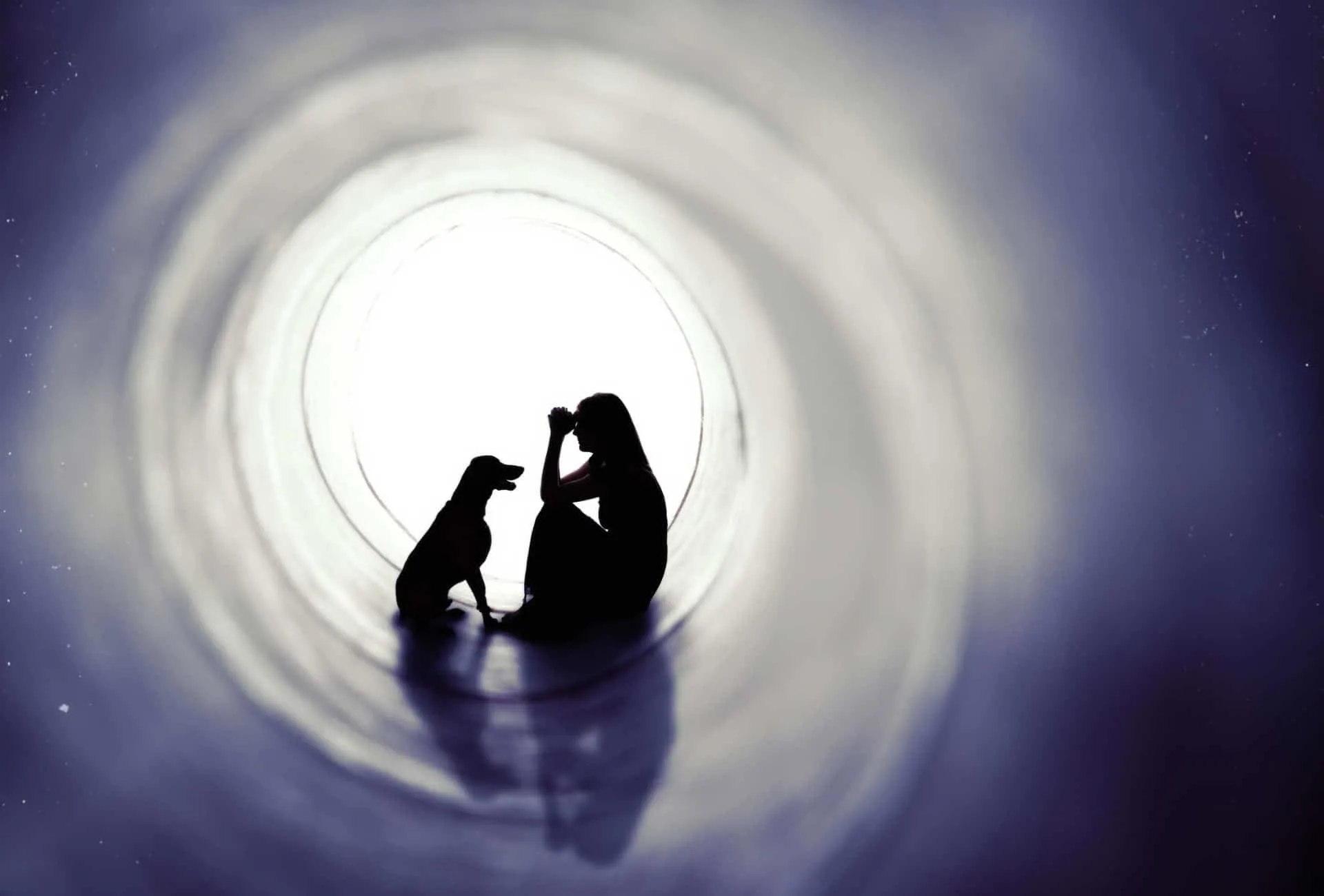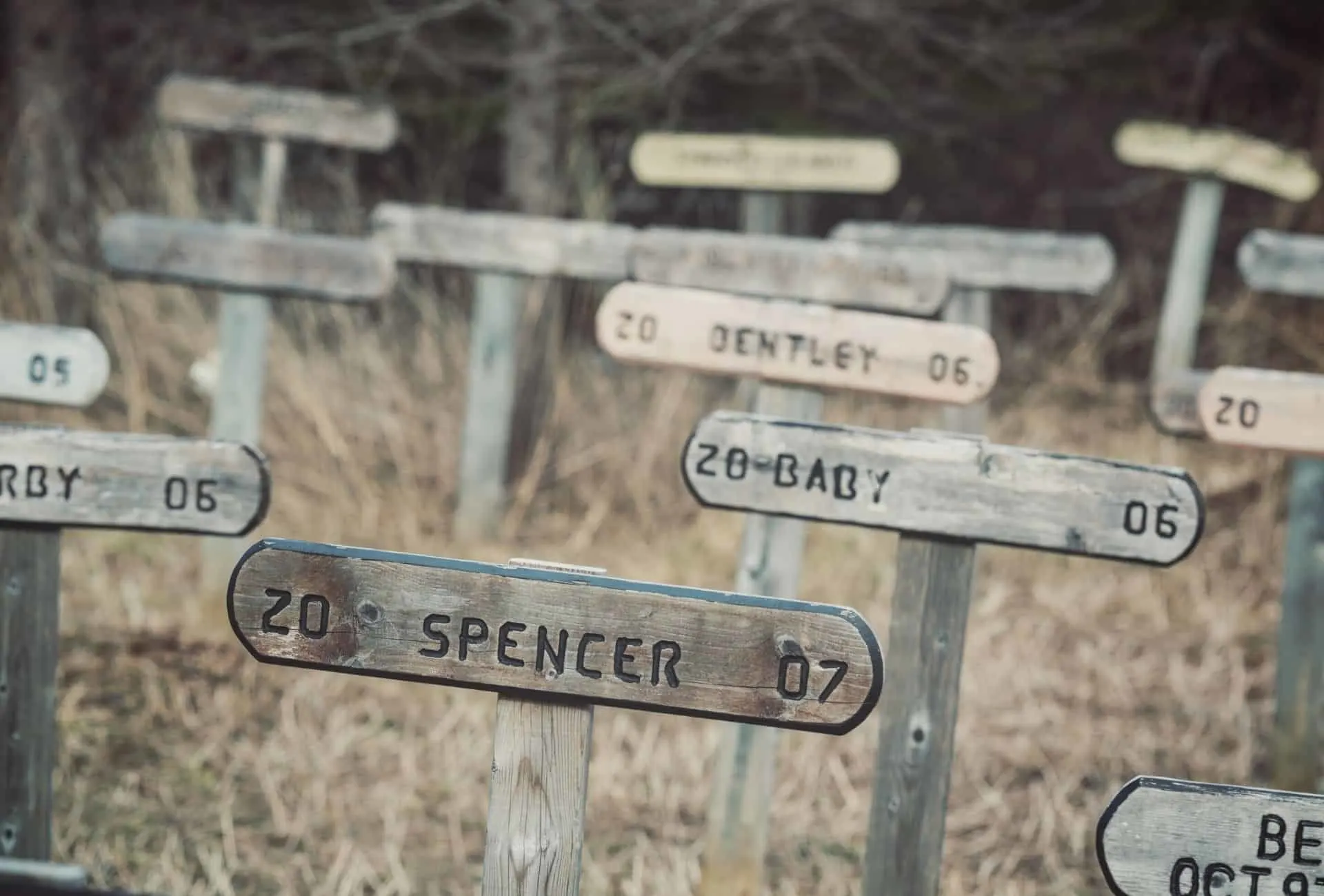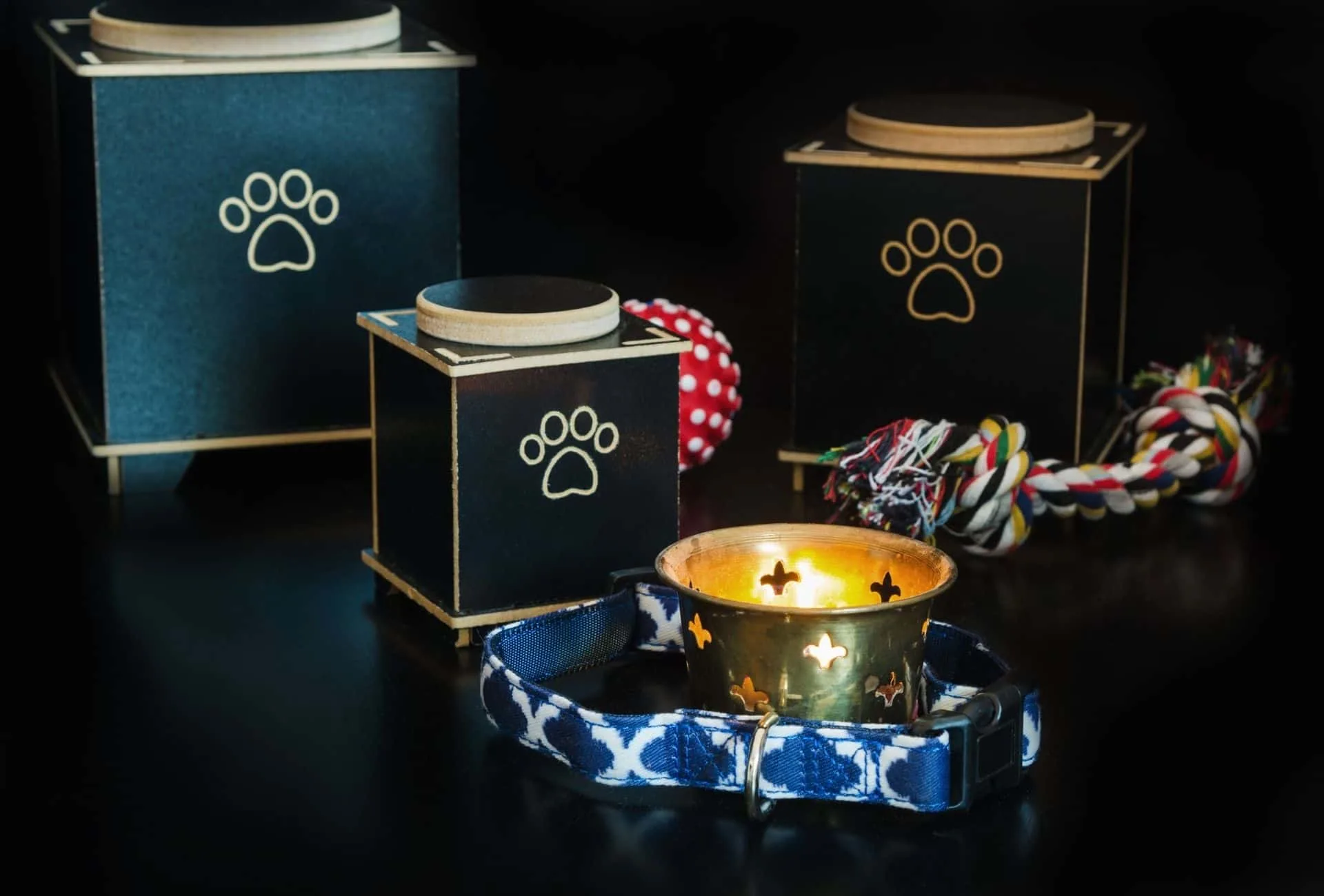After the tragic and devastating loss of a beloved pet, a family companion we’ve seen nearly every day of our lives for the past years or even decade, we want to remember those good times.
Pets are our best friends but when the time to say goodbye sadly comes, we have to ask ourselves whether or not we want our dogs to be cremated or not.
How exactly does dog cremation work? We’ll dive into that shortly.
However, I also have a couple of nice ideas for cremation jewelry and keepsakes so you’ll always have something to remember your dog.
Although it pains me to think of the day our beautiful Rottweiler Amalia will leave us, being confident that you know how to deal with the grief and the cremation process is somewhat comforting.
How Does Dog Cremation Work?
In many cases, people prefer being cremated instead of buried.
Dogs don’t make that choice so we have to make it for them.
Some owners prefer having their dog cremated but sometimes burial simply isn’t even an option.
For example, many municipalities (city or town with local government) won’t allow any sort of at-home burial.
Sometimes the graveyard is too far for people who want to visit regularly.
What would you do if burial isn’t a possibility for you?
The entire process of cremation reduces an animal’s remains to a powdery form which you can easily store in your favorite place and even carry with you if desired.
Beware of the standard default option since this often means a communal cremation, whereby your pet is cremated with other pets.
This may happen if you ask for cremation but don’t request a private cremation, and you won’t receive any ashes.
With the private cremation option, pets are cremated alone and ashes are made available.
Many dog lovers will request a private cremation so they can keep their pet’s ashes in something like a box or urn.
Owners also have the option of scattering those ashes in an area with sentimental value, much like many humans will do with relatives that have passed.
When cremated, your deceased pet is placed in a small space that is heated to extreme temperatures of about 1,500- 2,000 F (1093 C).
The process won’t take long at this temperature, and you’ll be left with resulting cremains.
Any metal implants can be returned by request, as long as the ceremony is not communal.

Many crematoriums have memorial grounds for disposal if you want.
You can choose to keep the cremains in a decorative urn, another type of container, spread them somewhere with sentimental meaning, or bury them.
Should I Bury or Cremate My Dog?
There are many things to consider when deciding to bury or cremate your deceased pet.
The first, most obvious yet weighted question is: Which option is right for you?
Burial is often the option of choice for many human families, making it a natural choice for many pet owners.
Before you decide to grab the shovel or check the local pet graveyard, there are certain things to think about.
Free Burial
Is it legal to bury pets in your area at all?
When a human is buried, the body is embalmed to prevent decomposition for as long as possible.
These days, they are often also confined within a vaulted casket made of metal or cement.
Though sometimes a vaulted casket can be an option (if requested), many pet owners opt for a simple burial.
Unfortunately, there are drawbacks associated with this.
As a body begins to decompose, several various gasses are released.
Though you might not be able to smell them, coyotes, other dogs, and many other animals generally can.
Other wild animals might dig up any buried remains, and there is a potential for environmental contamination.
Decomposition of a freely buried animal itself doesn’t offer a pretty description, though I won’t cover that any further.
Pet Cemetery
In the United States, pet cemeteries do exist as an option, scattered over the country (don’t worry, they’re not as portrayed in a Stephen K. novel… hopefully).
Though you may spend a few thousand on a human casket, pet caskets tend to be much cheaper.
Both the pet vaults and caskets could range around $100 USD.
Some may cost as much as $500-600 USD, but still much less than many human counterparts.
In fact, vaults designed for human children are often very similar, with a plus in terms of quality.
Burial plots often cost between $400-600 USD.
Communal Cremation
The actual process itself of cremating any animal or human can be difficult to imagine, though any adult has some idea that is probably close to the reality.
The ‘ashes’ aren’t exactly ashes, but rather carbonates, trace metals, and calcium phosphates.
In a communal cremation, any dog is cremated along with several other dogs.
Retrieving individual ashes becomes impossible.
Some centers offer ‘partitioned’ cremation, whereby an animal is separated from others by a partition while all are cremated together.
Private Cremation
Pets are cremated alone during a private cremation, nearly always available upon request.
Because the animal was cremated alone, ashes are made available to an owner.
There’s something else called alkaline hydrolysis.
Alkaline hydrolysis uses water, in addition to various chemicals, to break down human or animal tissue into base elements.
Though it might be an option, the process (disposal of subsequent fluids, etc.) is controversial and illegal in portions of the United States.
Dog Cremation Prices
In the United States, dog cremation will average from $100 to $150.
However, as with almost any service one purchases, the cost will vary depending on the market and location.
In areas such as Germany, pet cremation can range between 60€ to 410€.
However, laws may dictate even cremated remains must be buried (depending on location).
- Larger dogs will usually cost more to cremate than smaller dogs.
- Crematorium transfer fees are often charged in addition if your veterinarian doesn’t offer in-home services (many do).
- Communal cremation is the least costly option, while private cremation is the most and individual (partitioned) cremation falling in the middle.
Where do you live?
How much did your deceased pet weigh?
Which cremation option did you choose?

Some crematoriums will make it possible for the family to be present during the process.
Dog Cremation Urns
After your pet is cremated, what will you store the remains in?
Though you may be given a box or other type of container from the caretaker, urns are the preferred choice for our deceased canines.
The obvious choice besides pet stores and memorial service provides is the world wide web for a wide range of pet urns.
You can even find customized pet urns in the shape of your dog or cat.
You can literally find these in almost any shape, not just the traditional ‘vase’ Urn style.
Urns intended for humans would work too.
Cremation urns themselves are made from several various materials, including steel, wood, nature stone, ceramic, and glass.
The durability and life of the urn can depend on what it is made from.
What Urn Size Do I Need for My Dog?
What size urn will you need, anyway?
The generally agreed-upon rule is one cubic inch per pound of body weight, but some suggest adding 10 cubic inches.
The ashes themselves might weigh about 3.5% of your pet’s weight prior to cremation.
For example, a 50-pound pet would need at the very least a 50-60 cubic centimeter urn.
Where Can You Buy Pet Urns?
You can basically buy pet urns at almost any large pet store outlet you can imagine.
Pet crematoriums themselves will usually sell pet urns, but you must request a private cremation in order to get your pet’s ashes back.
Pet Cremation Jewelry
Have you ever heard of cremation jewelry? If not, the mere idea of it might sound almost unbelievable.
Cremation jewelry is in fact a reality, offering you a way to memorialize that beloved pet in a piece of jewelry that will literally last forever.
Since traditional diamonds came into being (before they were cut) around a billion years ago, there is no reason to think your cremation diamond won’t still be around after the human race has long died out.
If you want something other than a diamond, options also include cremation rings, bracelets, and key chains.
These have extra compartments for your deceased pet’s ashes.
Are Cremation Diamonds a Hoax?
Natural diamonds were formed under intense heat and pressure, somewhere between one to three billion years ago.
Diamonds then either surfaced on the ocean floor or after volcanic eruptions.
Anyone who specializes in the field wouldn’t call cremation diamonds any kind of hoax at all.
So no, cremation diamonds are not a hoax.
These diamonds share nearly the exact same chemical structure as naturally occurring diamonds.
However, the only real difference is they aren’t natural but designed by man, or laboratory grown.
If you consider anything not the exact same as that natural process and isn’t around a billion years old then cremation diamonds might not be the best choice for you.
Ashes are exposed to very high temperatures (5,000 F) allowing all elements except carbon to oxidize.
Carbon continues to be heated until turning to graphite, a process that may take weeks.
With extreme pressure of about 800,000 pounds per square inch, the graphite is pressed into a core with a metal catalyst.
Several more weeks are required for crystallization.
Step One: Carbon is isolated from the cremated remains.
Step Two: Via extreme pressure and heat, the diamond forms.
Step Three: The diamond is cut along specific structurally weak angles. Special diamond-tipped or ‘dusted’ tools or lasers are used.
Cut, Clarity, Color & Carat
A diamond’s ‘cut’ refers to the reflective qualities, dimensions, symmetry, and facets.
Is your diamond cut deep, shallow, brilliant, or dull? Finer cut diamonds offer more brilliance because the cut bears the largest impact on a diamond’s sparkle.
Brightness: Entails both the internal and external white light that is reflected from a diamond.
Fire: Describes the scattering of white light through all colors of the visual spectrum
Scintillation: Sparkle produced by a diamond
Carat/Karat: Measurement of weight, 1 Karat = 200 milligrams
If you don’t know a lot about diamonds, you might think they are all clear, or maybe sort of light blue. This has become a sort of Hollywood stereotype.
The color of a diamond stems from impurities, or elements that wouldn’t normally be added.
This doesn’t mean the diamond itself is impure in the sense that it is somehow sub-standard but contains other elements in addition to carbon. For example:
- Colorless (pure carbon)
- Blue (added boron)
- Yellow (added nitrogen)
Depending on the provider, you can basically select nearly any color you want. For example, both pink and amber are popular choices.
Naturally colored diamonds are often very rare and sometimes extremely valuable.

About clarity.
A diamond’s clarity measures any inherent ‘flaws’ that exist, which are often very small and sometimes only noticeable by a trained professional.
Believe it or not, about 30% of diamonds sold have been artificially enhanced to improve clarity.
Clarity is measured, from least flawed to most:
- Loupe clean
- VVS1
- VVS2
- VS1
- VS2
- SI1
- SI2
- P1 or I1
- P2 or I2
Diamond carats are further broken down into 100s or a system of 100 points.
The more karats the diamond, the larger it would be or more it might weigh.
The larger the diamond, the clearer any flaws might be.
If you wanted the larger option of a 2-3 karat diamond, going with a VS2 grade or better is a safe bet.
Let’s compare sizes.
To get an idea of size, the average wedding ring might be between 1.08 and 1.2 karats.
With a price tag of about 350 million USD, the so-called Hope Diamond weighs in at 69.69 karats.
What is the largest diamond?
This is still far from the largest diamond ever discovered, the Excelsior I, found in the late 1800s South Africa.
Before cut, the stone came in at about 995.2 metric karats.
After cut, most portions were sold to private buyers and the full locations of each aren’t publically known to this day.
Cost of Turning Your Dog‘s Ashes into a Diamond
So, how much does this incredible process really cost?
You’re probably thinking the cremation diamond process must be extremely expensive.
You would be right, the process isn’t cheap at all.
Just think about all of the time involved alone, outside of these unique laboratory conditions you can’t find anywhere else.
You’ll need to be able to supply the cremated remains.
You could start off around $1,999 USD on the low end.
Sometimes, a 3 carat blue diamond can run as much as $50,000 USD or more.
As always, prices will vary depending on your location.
This means you shouldn’t settle on the first price you see.
There are several manufacturers that provide this service.
At least the colored variations are far cheaper than those gifted with color by nature.
If you remember above, some colored diamonds are very rare and hard to find.
Even though it is the impurities that give them their color, they might be worth well over a clear diamond of similar size or even larger.
A 2 carat red cremation diamond might run you about a couple thousand dollars, while a 2 carat red natural diamond can be valued at millions.
The ‘purest’ red diamond known to man is called the Moussaieff Red, discovered in 1989, and weighs in at a mere 5.11 carats.
This still might be larger than any cremation diamond you could purchase, but the price tag of $20 million USD is nowhere near comparable.
You could have a 2 carat red cremation diamond at 0.00075% the price.
Not only is the chemical composition of laboratory made cremation diamonds nearly the same as naturally occurring diamonds, we are easily able to manipulate changes and color variances.
You can check out the following sites for pet cremation diamonds (I’m not affiliated with any of them):
I’m not personally endorsing any of these companies and you should always do in-depth research if you’re planning to buy something as expensive and important as a cremation diamond.
On the site of the cremation institute, many seemingly unrelated buyers from Lonite are complaining about late delivery, poor communication and the lack of a certificate.
These could just be isolated cases or the same could be true for other diamond cremation companies.
The more research you do beforehand, the safer you’ll be because in theory cremation diamonds are a wonderful idea.
Let me know if you have any concerns or questions in regards to the cremation process or a deceased pet in general!
Disclaimer: This blog post does not substitute veterinary attention and does not intend to do so. I am not a veterinarian or pet nutritionist. If your dog shows any sign of illness, call your vet.